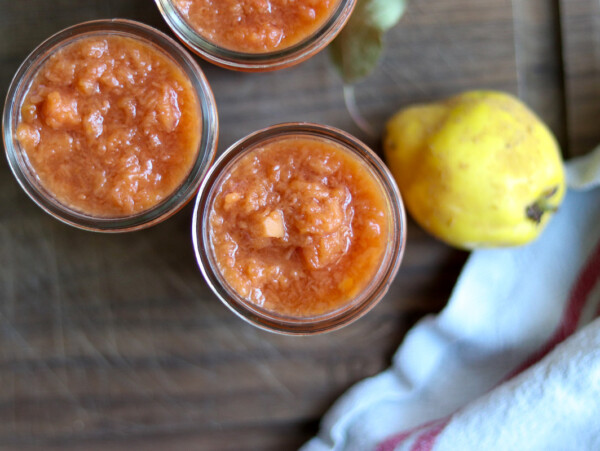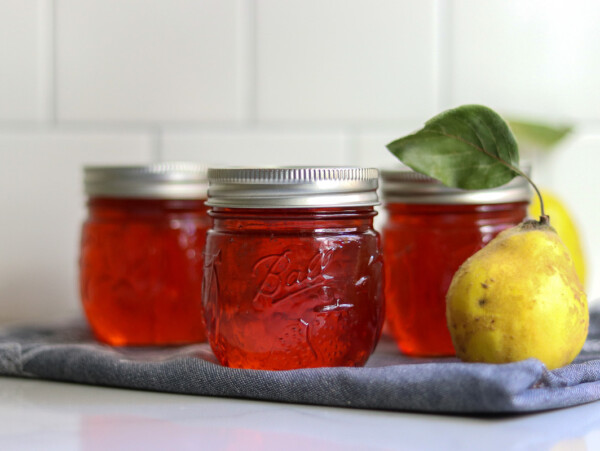This post may contain affiliate links. Please see our disclosure policy.
Canning quince is the perfect way to preserve quince for year-round use. These fragrant fruits are only edible once fully cooked for extended periods, and canning quince means you’ll have them ready to use at a moment’s notice, and you can even enjoy them right out of the jar.
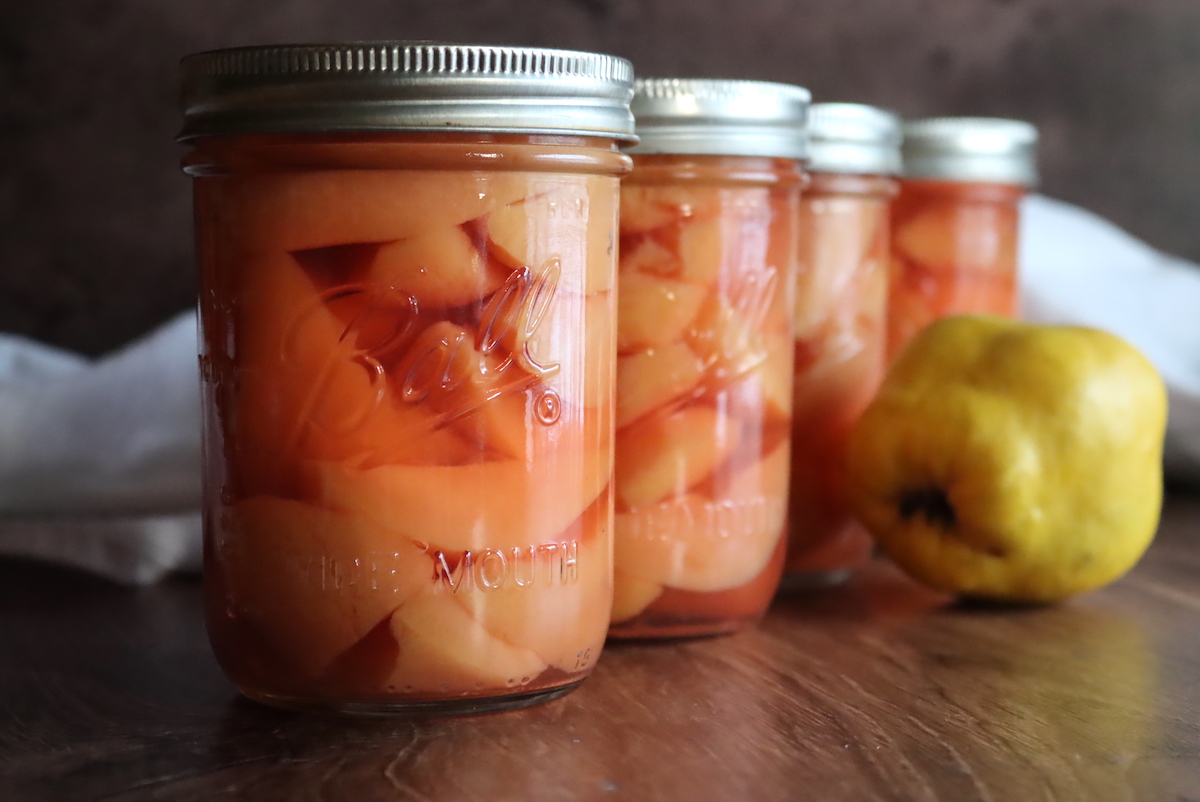
Quince are some of my husband’s favorite fruits, and he grew up eating them as homemade quince jelly and jam from a backyard tree. When we moved to our Vermont homestead many years ago, a quince tree was one of the first we planted.
These fragrant fruits are in the rose family, and they look like misshapen pears.
They’re inedible raw, but once fully cooked, they’re fragrant and delicious. A bit like a luscious sweet pear flavored with rosewater and a pinch of cardamom.
When I started cooking with quince, I experimented with all manner of quince recipes. I made the classic quince paste, of course, but also a luscious quince jam. I even made a few batches of quince wine, which were exceptional.
Still, we had more quinces, and I decided that I wanted to preserve quince for wintertime quince pies. Canning quince in slices is a perfect way, since the fruits must be poached before they’re used anyway (even when they’re going into a pie).
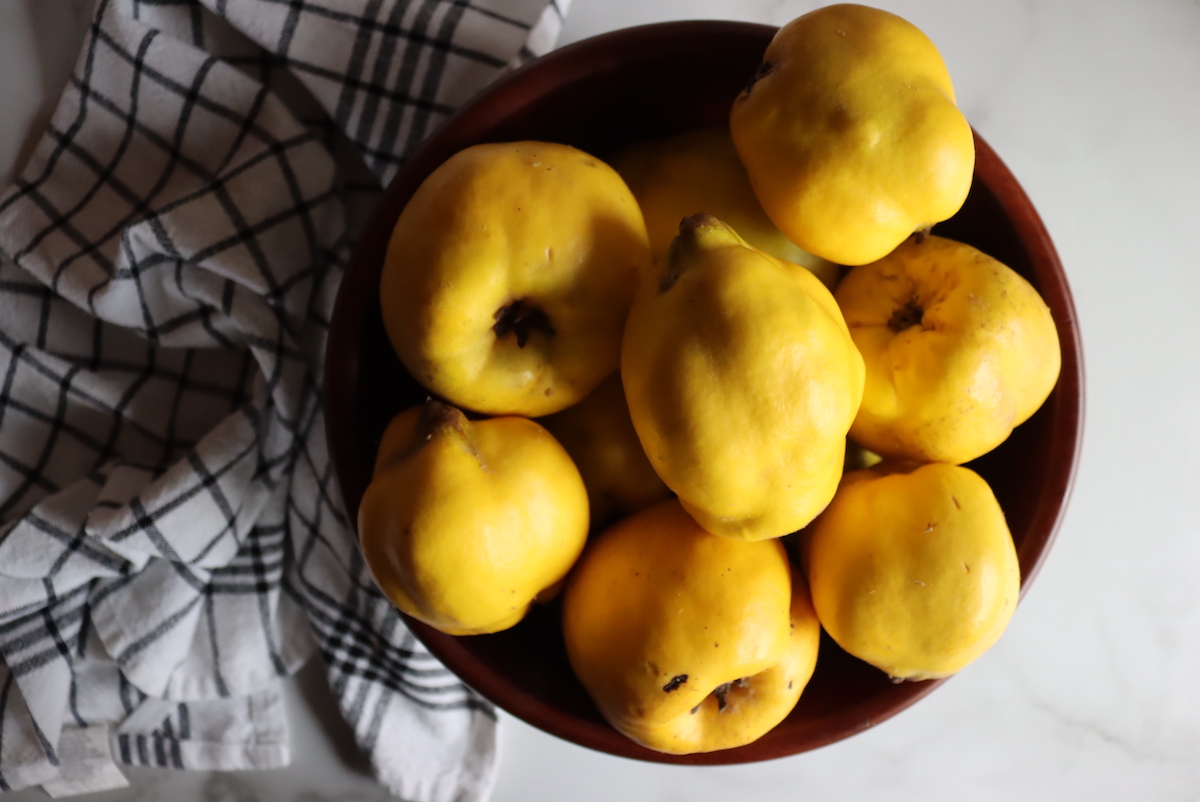
Are Quince Safe for Canning?
First off, can quince be canned?
Quinces have a pH of roughly 3.3 to 3.6 (source), which is well below the threshold for safe canning (pH 4.6). They’re about as acidic as apples (pH 3.3 to 3.9), and they’re a good bit more acidic than pears (pH 3.5 to 4.6).
While quince are much harder than pears or apples when raw, once cooked they’re about the same texture as cooked pears. They hold their shape pretty well during canning, and the end result has a texture much like canned pears as well.
Though the flavor is, of course, different, they’re perfectly fine for canning, provided they’re poached first.
This same canning recipe for quince is found in three of my canning books, including:
All of those canning books feature safe, tested canning recipes.

Preparing Quince for Canning
To prepare quince for canning, you’ll need to slice and core them. Slicing is important because they won’t fit into jars whole, and even if they would, they’re much too big for canning whole. They won’t process correctly.
Coring is important because you want to remove the seeds, and because the core is incredibly hard and fibrous.
I choose to peel them, but that’s optional. You can leave the peels on, and some people actually prefer quince that way. The peels are incredibly fragrant, and they have a lot of flavor. Unlike apple and pear peels, they get soft when cooked, so they won’t be stringy in the jars.
Still, I pretty much always peel fruit when canning.
Quince are particularly difficult to peel, since they’re so hard, but I found my super sharp Victorinox peeler did the job well.
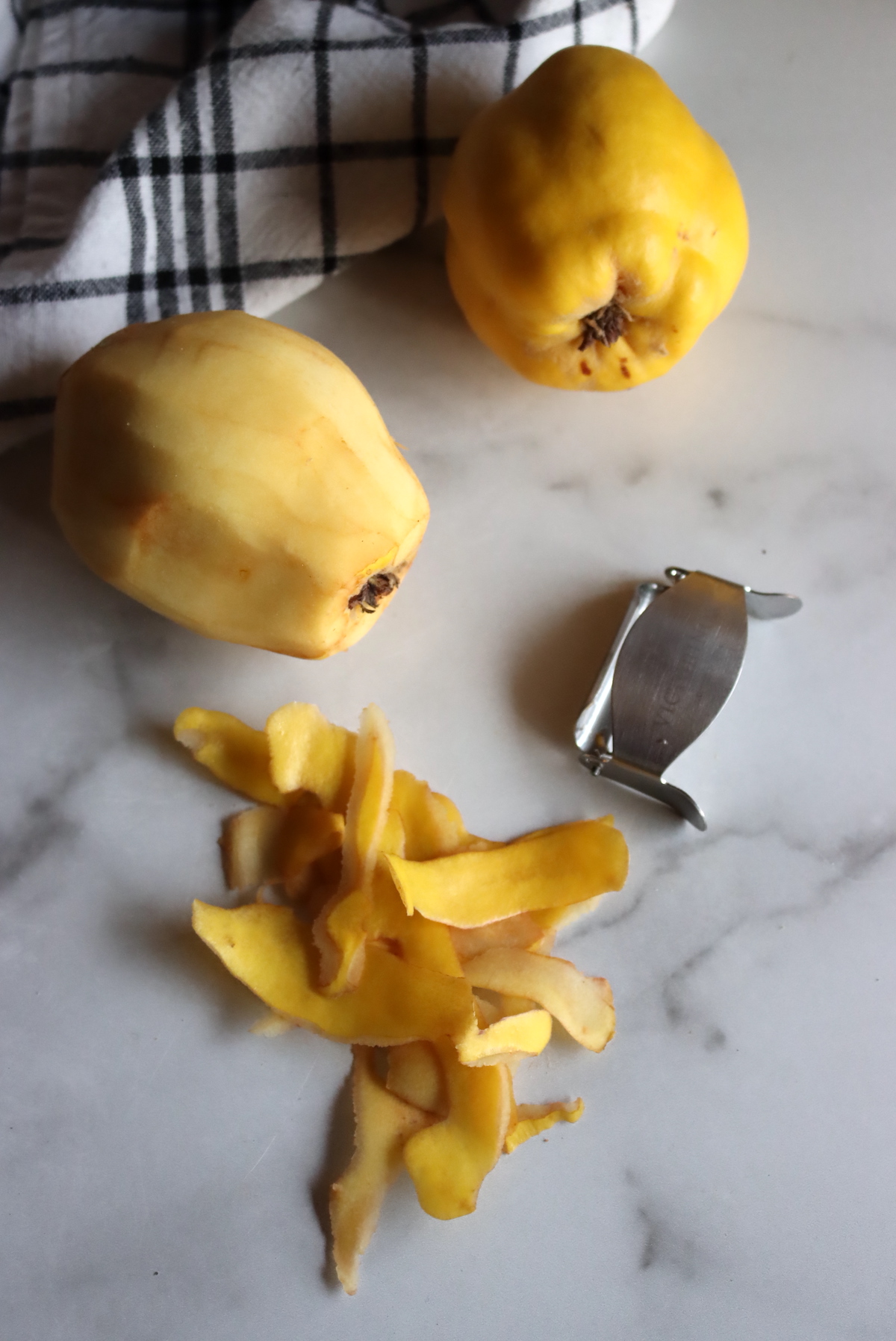
Be very careful when cutting and peeling quince. They’re hard to chop, so watch your fingers. They’re a bit easier when fully ripe, but still even fully ripe, they’re harder than unripe pears/apples.
Make sure you’re thorough in removing the cores from the quince. Quince cores are incredibly gritty, much more so than pears.
The fruits themselves are tender and succulent when canned, but a sliver of core left leaves you a line of gritty sand attached that’s quite unpleasant.
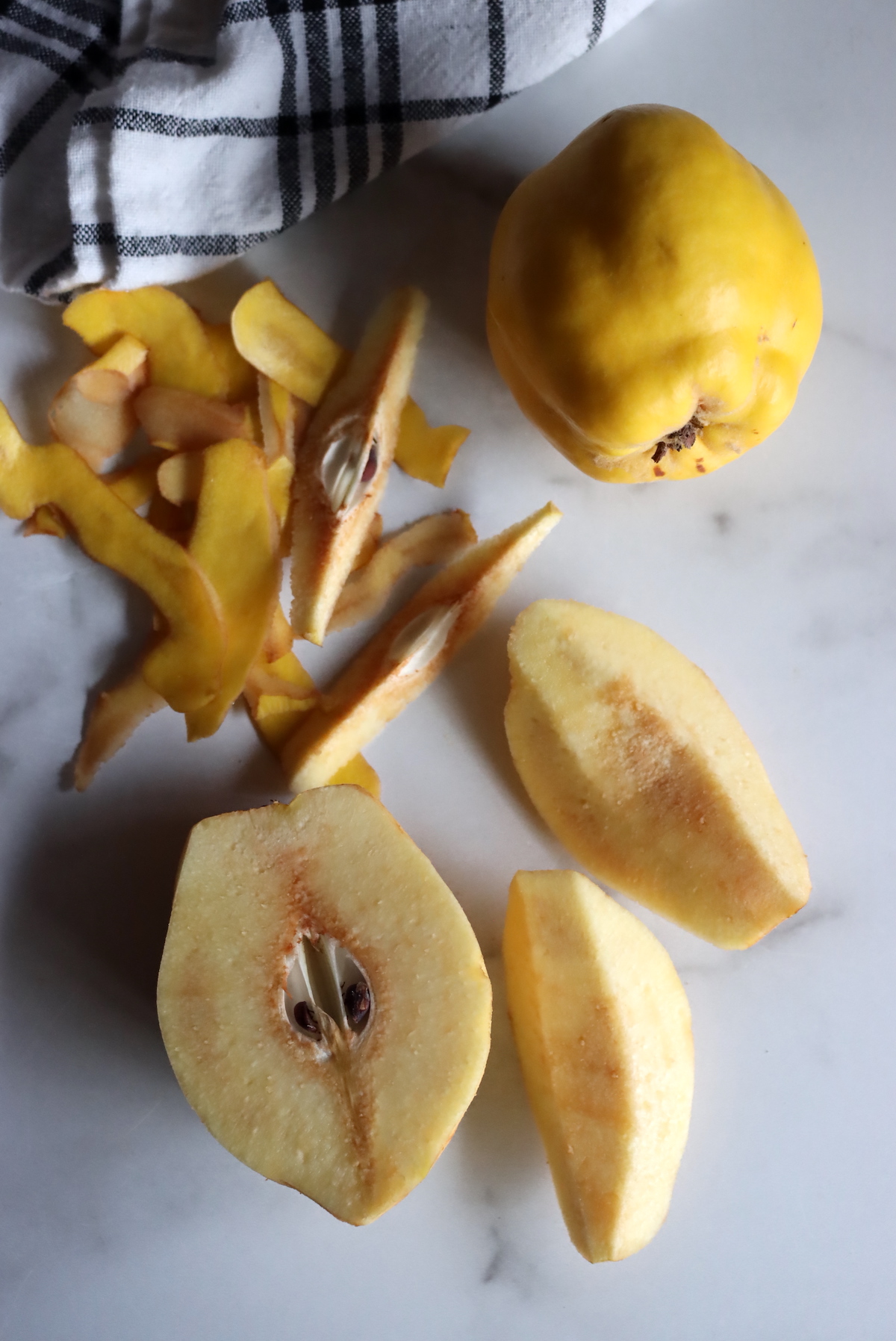
The fruit will brown when cut, much like apples and pears, but that actually disappears when cooking, so you don’t have to worry about treating them with lemon juice to prevent browning. They’ll turn a rosy shade of pink when cooked, even if they’ve browned when raw.
Canning Quince
When canning pears and canning apples, they’re simply cooked for about 5 minutes to warm them before loading them hot into canning jars. Quince, on the other hand, require extended cooking before they can be packed into jars.
Make your canning syrup (discussed below) and then poach the quince slices in the syrup for 30 to 40 minutes, until they turn a rosy pink and are tender enough to pierce with a fork. The total time will depend on the variety of quince, as some take longer to cook than others.
Keep the quince covered as they poach, and add water if necessary to keep the liquid level the same. (Don’t let them cook dry, you’ll need this liquid for canning.)
Once the quince are fully cooked, tender, and rosy pink, remove them from the heat and pack them into jars using a slotted spoon. Pour the cooking syrup over the top of the fruit in the jars, leaving 1/2 inch headspace.
Canning timetables are the same as for canning pears, which is 20 min for pints, 25 for quarts below 1,000 feet in elevation. Be sure to adjust for altitude at higher elevations.
(If you happen to have extra cooking liquid left over from poaching the quince, you can continue to cook it down to make quince jelly.)
Altitude Adjustments for Canning Quince
The Altitude adjustments for canning quince are as follows:
- For 0 to 1,000 Feet in Elevation – Process pints for 20 minutes and quarts for 25 minutes
- For 1,001 to 3,000 Feet in Elevation – Process pints for 25 minutes and quarts for 30 minutes
- For 3,001 to 6,000 Feet in Elevation – Process pints for 30 minutes and quarts for 35 minutes
- Above 6,000 Feet in Elevation – Process pints for 35 minutes and quarts for 40 minutes

Syrup for Canning Quince
I generally use extra light syrup when canning sweet fruits like quince (or apples, pears and peaches). It’s roughly the same sweetness as the poached quince themselves, so it doesn’t add sweetness, but simply maintains its natural fruit flavor.
If you canned quince in plain water, their natural sweetness would leach into the canning liquid, and they’d taste washed out. You need some to keep them sweet as they are. (You can also use honey or maple instead, and honey is an especially popular choice for antique fruits like quince.)
The recipe for extra light syrup is as follows:
For a 7 quart canner batch ~ 10 1/2 cups water and 1 1/4 cups sugar
For a 9 pint canner batch ~ 6 1/2 cups water and 3/4 cups sugar
If you like sweeter canned quince, you can use anything from light up to heavy syrup for water bath canning. See this canning syrup table if you’d like the measurements for other syrup concentrations.
Quince Recipes
Looking for delicious quince recipes?
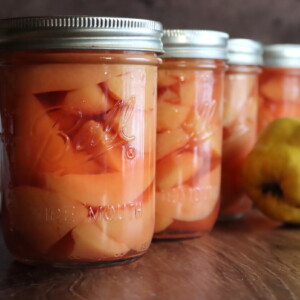
Canning Quince
Equipment
Ingredients
- 9 to 10 lbs quince
- 6 1/2 cups water
- 3/4 cups sugar
Instructions
- Prepare a water bath canner for hot pack (water simmering at about 180 F) before beginning, and also prepare jars, lids, and rings.
- Prepare the quince by peeling, coring and slicing. Be careful here, quince are very hard to cut, watch your fingers.
- Add the water and sugar to a large pot and bring it to a boil, stirring to dissolve the sugar.
- Add the sliced quince, return to a boil and then turn the heat down to low.
- Simmer the quince covered until they're fork tender, pink and fragrant (about 30 to 40 minutes, or longer, depending on the variety). Add water as necessary to maintain the liquid level.
- Remove the quince from the heat and use a slotted spoon to pack into prepared canning jars, leaving 1/2 inch headspace.
- Ladle the cooking liquid over the quince in jars, maintaining 1/2 inch headspace.
- Debubble jars, adjust headspace, apply 2-part canning lids and seal to finger tight.
- Process jars in a water bath canner for 20 minutes (pints) and 25 minutes (quarts), adjusting for altitude (see below).
- When the canning time is complete, remove the jars to cool on a towel on the counter. Check seals after 12-24 hours, and store any unsealed jars in the refrigerator for immediate use.
- Properly canned and sealed jars of quince will maintain peak quality on the pantry shelf for 12 to 18 months, and be good to eat for much longer. Refrigerate after opening.
Notes
Yield
It takes about 1 pound of fresh quince to make a pint of canned quince slices. You can use other jar sizes, including half pint and quart, but plan on about 1/2 pound per cup (8 oz), 1 pound per pint (16 oz) or 2 lbs per quart (32 oz). These measurements are approximate and are in whole quince as purchased before they've been peeled and cored. You can adjust the total quantity in this recipe to suit your needs, but I've set it as a "standard" 9-pint canner batch.Canning Syrup
I'm packing these in extra light syrup, which maintains their sweetness, rather than making them sweeter. You can use more or less sugar based on your preference.The recipe for extra light syrup is as follows:
For a 7 quart canner batch ~ 10 1/2 cups water and 1 1/4 cups sugar For a 9 pint canner batch ~ 6 1/2 cups water and 3/4 cups sugar If you like sweeter canned quince, you can use anything from light up to heavy syrup for water bath canning. See this canning syrup table if you’d like the measurements for other syrup concentrations.Altitude Adjustments for Canning Quince
The altitude adjustments for canning quince are as follows:- For 0 to 1,000 Feet in Elevation – Process pints for 20 minutes and quarts for 25 minutes
- For 1,001 to 3,000 Feet in Elevation – Process pints for 25 minutes and quarts for 30 minutes
- For 3,001 to 6,000 Feet in Elevation – Process pints for 30 minutes and quarts for 35 minutes
- Above 6,000 Feet in Elevation – Process pints for 35 minutes and quarts for 40 minutes
Nutrition
Nutrition information is automatically calculated, so should only be used as an approximation.
Autumn Canning Recipes
Putting up more than quince this season?
- Canning Apple Slices
- Canning Apple Pie Filling
- Apple Jam
- Apple Butter
- Pear Jam
- Pear Jelly
- Canning Pumpkin (This is a Pressure Canning Recipe)
- Canning Sweet Potatoes (again, you’ll be pressure canning for these)
Food Preservation Guides
I love home canning, but it’s not the only way to put up the harvest!
- Beginners Guide to Root Cellaring (without a root cellar)
- Beginners Guide to Lacto-Fermentation
- 100+ Dehydrator Recipes
- How to Make Apple Cider Vinegar
- Homemade Hard Cider

